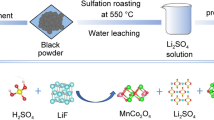Abstract
We displayed that the low-cost natural zeolite with molecular sieve structure can be used as the carrier of sulfur in lithium-sulfur batteries. Meanwhile, a simple salt-washing method was implemented on zeolite for dredging the internal microchannel to improve the ability of adsorption, ion exchange and sulfur loading. The experimental results show that the first specific discharge capacities of zeolite/S and salt-washed zeolite/S cathode under 0.2 C current density are 950.7 and 1 116.8 mAh/g, respectively, and corresponding discharge capacities remain at 350.6 and 604.2 mAh/g after 300 cycles. The first specific discharge capacity of salt-washed zeolite/S composite is 17.5% higher than that sample without salt-washing, and the corresponding ionic conductivity is improved.
Similar content being viewed by others
References
Bruce PG, Freunberger SA, Hardwick LJ, et al. Li-O2 and Li-S Batteries with High Energy Storage[J]. NatureMaterials, 2012, 11(1): 19
Ji X, Lee KT, Nazar LF. A Highly Ordered Nanostructured Carbon-Sulphur Cathode for Lithium-sulphur Batteries[J]. Nature Materials, 2009, 8(6): 500
Huang C, Xiao J, Shao Y, et al. Manipulating Surface Reactions in Lithium-sulphur Batteries using Hybrid Anode Structures[J]. Nature Communications, 2014, 5: 3015
Schuster J, He G, Mandlmeier B, et al. Spherical Ordered Mesoporous Carbon Nanoparticles with High Porosity for Lithium-sulfur Batteries[J]. Angewandte Chemie International Edition, 2012, 51(15): 3 591–3 595
Li Z, Zou Y, Duan J, et al. Coral-like Cop Hollow Composites as Effective Host Cathodes for Lithium-sulfur Batteries[J]. Ionics, 2019: 1–11
Dörfler S, Hagen M, Althues H, et al. High Capacity Vertical Aligned Carbon Nanotube/Sulfur Composite Cathodes for Lithium-sulfur Batteries[J]. Chemical Communications, 2012, 48(34): 4 097–4 099
Li Z, Zou Y, Duan J, et al. Long-cycle Stability for Li-S Batteries by Carbon Nanofibers/Reduced Graphene Oxide as Host Cathode Material[J]. Ionics, 2019: 1–10
Wang JZ, Lu L, Chousair M, et al. Sulfur-graphene Composite for Rechargeable Lithium Batteries[J]. Journal of Power Sources, 2011, 196(16): 7 030–7 034
Ji X, Evers S, Black R, et al. Stabilizing Lithium-sulphur Cathodes Using Polysulphide Reservoirs[J]. Nature Communications, 2011, 2: 325
Hayashi H, Cote AP, Furukawa H, et al. Zeolite A Imidazolate Frameworks[J]. Nature Materials, 2007, 6(7): 50
Kubů M, Žilková N, Zones SI, et al. Three-dimensional 10-Ring Zeolites: The Activities in Toluene Alkylation and Disproportionation[J]. Catalysis Today, 2016, 259: 97–106
Fechete I, Wang Y, Védrine JC. The Past, Present and Future of Heterogeneous Catalysis[J]. Catalysis Today, 2012, 189(1): 2–27
Baerlocher C, Mccusker LB, Olson DH. Atlas of Zeolite Framework Types[M]. Elsevier, 2007
Blum Z. Utilization of Zeolite Y in the Removal of Anionic, Cationic and Nonionic Detergents during Purification of Proteins[J]. Biotechnology Techniques, 1991, 5(1): 49–54
Masters AF, Maschmeyer T. Zeolites-From Curiosity to Cornerstone[J]. Microporous and Mesoporous Materials, 2011, 142(2–3): 423–438
Nunes-Pereira J, Lopes AC, Costa CM, et al. Microporous Membranes of Nay Zeolite/Poly (Vinylidene Fluoridetrifluoroethylene) for Li-ion Battery Separators[J]. Journal of Electroanalytical Chemistry, 2013, 689: 223–232
Yue Y, Guo B, Qiao ZA, et al. Multiwall Carbon Nanotube@ Zeolite Imidazolate Framework Composite from a Nanoscale Zinc Oxide Precursor[J]. Microporous and Mesoporous Materials, 2014, 198: 139–143
Davis ME, Lobo RF. Zeolite and Molecular Sieve Synthesis[J]. Chemistry of Materials, 1992, 4(4): 756–768
Perić J, Trgo M, Medvidović NV. Removal of Zinc, Copper and Lead by Natural Zeolite-A Comparison of Adsorption Isotherms[J]. Water research, 2004, 38(7): 1 893–1 899
Ören AH, Kaya A. Factors Affecting Adsorption Characteristics of Zn2+ on Two Natural Zeolites[J]. Journal of Hazardous Materials, 2006, 131(1–3): 59–65
Merrikhpour H, Jalali M. Comparative and Competitive Adsorption of Cadmium, Copper, Nickel, and Lead Ions by Iranian Natural Zeolite[J]. Clean Technologies and Environmental Policy, 2013, 15(2): 303–316
Han R, Zhang J, Han P, et al. Study of Equilibrium, Kinetic and Thermodynamic Parameters about Methylene Blue Adsorption onto Natural Zeolite[J]. Chemical Engineering Journal, 2009, 145(3): 496–504
Wajima T. Ion Exchange Properties of Japanese Natural Zeolites in Seawater[J]. Analytical Sciences, 2013, 29(1): 139–141
Ćurković L, Cerjan-Stefanović Š, Filipan T. Metal Ion Exchange by Natural and Modified Zeolites[J]. Water Research, 1997, 31(6): 1 379–1 382
Chen X, Wang Y, Wang Y, et al. Hierarchical High-porosity Graphene Oxide-porous Carbon/Sulfur Composite with Sodium Chloride as Temporary Space Holders for High-performance Lithium-sulfur Batteries[J]. Chem. Electro. Chem., 2019, 6(10): 2 667–2 674
Sukharenko VI, Usenko SI, Borisova LI, et al. Studying the Composition and Properties of Zeolitecontaining Rocks of Tatarshatrashane Occurrence[M]. Book of Abstracts, 2006: 226
Ye H, Yin YX, Xin S, et al. Tuning the Porous Structure of Carbon Hosts for Loading Sulfur toward Long Lifespan Cathode Materials for Li-S Batteries[J]. Journal of Materials Chemistry A, 2013, 1(22): 6 602–6 608
Wu Y, Xu C, Guo J, et al. Enhanced Electrochemical Performance by Wrapping Graphene on Carbon Nanotube/Sulfur Composites for Rechargeable Lithium-sulfur Batteries[J]. Materials Letters, 2014, 137: 277–280
Li GC, Li GR, Ye SH, et al. A Polyaniline-coated Sulfur/Carbon Composite with an Enhanced High-rate Capability as a Cathode Material for Lithium/Sulfur Batteries[J]. Advanced Energy Materials, 2012, 2(10): 1 238–1 245
Wang J, Liu L, Ling Z, et al. Polymer Lithium Cells with Sulfur Composites as Cathode Materials[J]. Electro. Chimica. Acta, 2003, 48(13): 1 861–1 867
Wei Y, Yan Y, Zou Y, et al. The Ternary PANI@ BDC/S Composite Cathode with Enhanced Electrochemical Performance in Lithium-sulfur Batteries[J]. Journal of Electroanalytical Chemistry, 2019
Lasia A. Electrochemical Impedance Spectroscopy and Its Applications[M]. Modern Aspects of Electrochemistry, 2002: 143–248
Stoller MD, Ruoff RS. Best Practice Methods for Determining an Electrode Material’s Performance for Ultracapacitors[J]. Energy & Environmental Science, 2010, 3(9): 1 294–1 301
Wang Y, Huang J, Chen X, et al. Powder Metallurgy Template Growth of 3D N-Doped Graphene Foam as Binder-free Cathode for High-performance Lithium/Sulfur Battery[J]. Carbon, 2018, 137: 368–378
Author information
Authors and Affiliations
Corresponding authors
Additional information
Funded by the National Natural Science Foundation of China(Nos.11627801, 51772254, 11502225, and 51375017), and the Natural Science Foundation of Hunan Province of China(No.2019JJ50578)
Rights and permissions
About this article
Cite this article
He, Y., Du, Z., Su, Y. et al. Salt-washing Improvement of the Electrochemical Properties of Zeolite-sulfur Cathode for Lithium-sulfur Batteries. J. Wuhan Univ. Technol.-Mat. Sci. Edit. 35, 665–670 (2020). https://doi.org/10.1007/s11595-020-2304-7
Received:
Accepted:
Published:
Issue Date:
DOI: https://doi.org/10.1007/s11595-020-2304-7




